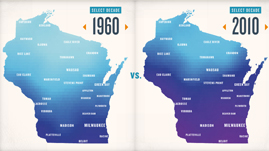Teachers' Domain - Digital Media for the Classroom and Professional Development
User: Preview

Source: Produced by the Wisconsin Educational Communications Board.
This interactive resource produced by the Wisconsin Educational Communications Board allows users to investigate changes in Wisconsin’s average annual temperature dating back to 1960 and projected to 2090. The color-scaled interactive maps are based on records collected from cooperative weather stations as well as climate modeling that predicts future changes.
Wisconsin’s climate has always been changing—most notably as the last Ice Age ended, glaciers melted, and the plants and animals present today slowly made their way north. It will continue to change into the future, but now due in large part to human activity, and at a rate much faster than at any other point in history. To make predictions about the rate and magnitude of future climate changes in Wisconsin, climatologists at the University of Wisconsin-Madison analyzed past climate data and modeled future projections for Wisconsin.
Daily weather data collected from cooperative weather stations across Wisconsin between 1950 and 2006 show that, statewide, the annual average temperature has risen by 1.1°F since 1950—consistent with global trends. Average temperatures have risen fastest in winter and spring, while summer and fall have actually cooled a bit. There are geographic differences as well; winters in northwestern Wisconsin have warmed most, by as much as 4.5°F.
These recent changes in temperature are corroborated by observations in nature. Records of springtime events such as bird migration and flowering, kept in Sauk County by Nina Leopold Bradley, show that many such events occur about one week earlier now than 60 years ago. University of Wisconsin-Madison lakes researcher John Magnuson has documented a steady decline in the length of time that Wisconsin lakes are frozen, with an average of 6 fewer days of ice cover on Madison’s Lake Mendota for every decade between 1956 and 2006.
The rate of climate change is predicted to increase over the next 40 years. Based on climate modeling specific to Wisconsin, scientists at University of Wisconsin-Madison’s Center for Climatic Research predict that the state's annual average temperature will warm by 4–9°F by mid-century. The winter will continue to warm the most, especially in the northwestern counties. Days that exceed 90°F are expected to increase by 3 weeks in the southern part of the state, and one week in the north. The number of days with sub-zero temperatures is expected to decrease by 2–3 weeks across the state.
The future projections, when viewed alongside the changes of the last five decades, give a sense of the challenges Wisconsin could face. If an annual average temperature increase of a degree or two has already caused observable changes across the landscape, what will an increase of 4,7, or even 9°F bring? The state’s natural resources support a significant portion of Wisconsin's economy, including tourism, outdoor recreation, forest products, Great Lakes shipping, agriculture, and water-intensive manufacturing. In addition, if climatic conditions change and exceed the range of conditions that plants and animals tolerate, they will disappear from the region. Though there is some uncertainty about the rate and magnitude, Wisconsin’s climate will continue to change.
Here are suggested ways to engage students with this video and with activities related to this topic.
 Loading Standards
Loading Standards